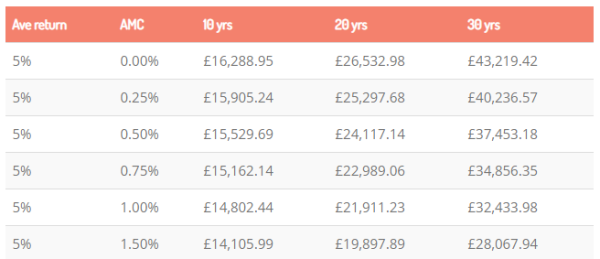Apr
2024
Investing Basics: Why Fund Fees Are Important
DIY Investor
24 April 2024
Investors often assume their most important choice when it comes to choosing funds is where or what those funds invest in – by Christian Leeming.
Stay local with UK companies or go global? Large caps only or medium or even smaller companies too? A global fund that invests in developed markets only or one that invests in emerging markets?
What the funds invest in is of course important. But it’s not the most important factor when it comes to your portfolio’s long-term returns.
‘another factor that will have a big influence on your portfolio value is fund fees’
When investing for the long term, many people choose funds that spread risk and give balanced exposure to the world economy.
If we take into account such a balanced portfolio, another factor that will have a big influence on your portfolio value is fund fees.
Almost every fund, even index-trackers, charges some kind of fee (fund providers are businesses after all and fees are their revenue model).
The complication is that fund charges can vary widely. They can be as low as 0.1% per year and as high as 1.5%. Usually the funds with the lowest fees are index-trackers like a FTSE 100 or a FTSE All-Share tracker.
Index-tracker fees are low because the provider doesn’t have to research companies, it just replicates the index.
Conversely, funds with the highest fees are usually actively managed funds that invest in companies that involve a lot of research. And that’s understandable because paying the salaries of fund managers and teams of analysts means greater overheads.
Do you get what you pay for?
Unfortunately, the old idiom ‘you get what you pay for’ doesn’t ring true when it comes to funds.
Numerous studies, including this Morningstar study, have shown that in fact the opposite is often the case. The higher a fund’s fees, the greater the risk it will underperform.
‘The higher a fund’s fees, the greater the risk it will underperform’
The reason is simple. These studies have found no direct relation at all between the level of fees and average investor returns over the long term.
But over many years, the difference in fees begins to add up. The table below shows how big a difference fees can make to compounded returns over 10, 20 and 30 years. The figures are based on a starting investment of £10,000 and returns compounded annually.
Between a fund charging 0.25% and another charging 1.5%, the difference over 30 years, just on a starting investment of £10,000 with nothing else contributed over the period, is over £12,000.
There are many actively managed funds whose target is to beat an index and there’s a strong chance they charge a fee of 0.75%+.
‘hunting out the lowest fees between comparable funds may give you the best chance of getting the best returns’
You can probably get a tracker fund that mirrors the same index for between 0.1% and 0.25%.
The same Morningstar study looked at 9,400 European funds between June 2008 and June 2018 found that fewer than 25% of actively managed funds outperformed their passive counterparts.
An investor would understandably expect a fund with higher fees to provide better returns.
The Morningstar data suggests that’s not historically been the case.
So all things considered, hunting out the lowest fees between comparable funds may give you the best chance of getting the best returns on a well-diversified portfolio.
Commentary » Financial Education » Investment trusts Commentary » Latest » Mutual funds Commentary » Mutual funds Latest » Take control of your finances commentary

Leave a Reply
You must be logged in to post a comment.